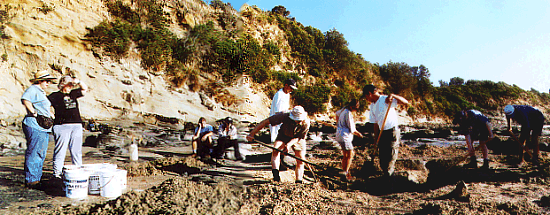| Monash home | About Monash | Faculties | Campuses | Contact Monash |
| Staff directory | A-Z index | Site map |
| Monash home | About Monash | Faculties | Campuses | Contact Monash |
| Staff directory | A-Z index | Site map |
Dinosaur DreamingField report 1997
Lesley Kool Dinosaur Dreaming 1997 was the fourth and most successful field trip to the Flat Rocks site, Inverloch, Victoria. Over 1300 bones and teeth were catalogued including the first Early Cretaceous mammal jaw found in Victoria. The six-week field trip involved almost 40 volunteers, some coming from as far away as Germany and the United States to join the excavations. 
Clearing the Flat Rocks site, February 1997 The Flat Rocks site was discovered in 1991 as part of a prospecting program whereby the Strzelecki coastal shore-platform, from San Remo to Inverloch, was systematically searched at low tide, for exposed bones. Large areas of the shore-platform are often covered by sand, but as luck would have it, on the day the area west of Inverloch was prospected, the sand had been swept from the rocks by strong winds and high water. Consequently, more than 20 small bones were discovered in an exposed fossil layer approximately 4 metres wide, stretching up the beach and into the cliff. This represented the largest concentration of fossil bones found anywhere along the Victorian coastline, and after a preliminary excavation the following year, extensive excavations began in 1994. There were three objectives for the 1997 excavations:
The second and third objectives were completed satisfactorily. The first objective remains an ongoing project as it became obvious that more of the overlying sandstone needed to be removed to gain access to the deepest part of the site. This will be a major priority next field season as it is from this area that the mammal jaw was discovered. After extensive research, Dr. Tom Rich has come to the conclusion that the mammal jaw is a well-preserved dentary of a tribosphenic mammal which shows characteristics of primitive placental mammals. This is undoubtedly the most exciting discovery from the Early Cretaceous of Victoria. This possible placental mammal is of similar age to Prokennalestes from the Early Cretaceous of Mongolia and the first of its kind of this age from Gondwana. Dr Rich, a palaeomammalogist, has been searching for these elusive mammals in Australia for nearly 26 years, and so was obviously delighted with the find. Additional preparation of some of the remaining 1300 bones recovered this field season has revealed the possibility of the first embryonic hypsilophodontid femur from the Early Cretaceous of Victoria. This tiny femur is only 29mm long, and it has been estimated that the original dinosaur would have only been approximately 23cm in length. Tiny limbs have been found from previous digs, but this is the first bone to be positively identified as a hypsilophodontid femur. One specimen caused some excitment when it was found because its cross section looked skull-like. After preparation it was obvious that it was not a skull but a centrum (part of a vertebra). However, it was unlike any other centrum previously prepared from this site. Its internal structure contained large air pockets which had been infilled with mudstone and fine-grained sandstone. It also possessed large pleurocoels on either side of the centrum, which are characteristic of saurischian dinosaurs. The centrum measured approximately 3 cm long and probably belonged to a juvenile animal, as the sutures between the centrum and the missing dorsal processes were not ossified. Its size and internal structure suggests it is probably from a medium-sized theropod dinosaur, yet unnamed. Another specimen, a badly damaged tibia approximately 20cm long, appears to have 4 or possibly 5 puncture marks along one side of the shaft, suggestive of tooth marks of some predator or scavenger. Further investigation of these marks is necessary to confirm their identity. A number of thin walled, hollow limbs have been found, but most of them have no ends preserved by which they can be identified. However, this year a hollow limb, infilled with sediment and with one end preserved has been prepared. Preliminary research suggests that it may be the distal end of a pterosaur metacarpal or metatarsal. Although the limb is only approximately 2 cm long, a foramen close to the distal end has been preserved which appears to be characteristic of pterosaur limbs. This foramen is not present in dinosaur, turtle or other reptilian limbs. However, further research is necessary to confirm this initial identification. Next: Future plans... |